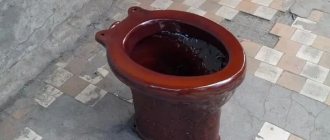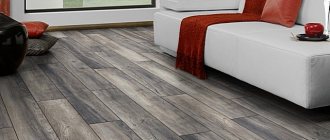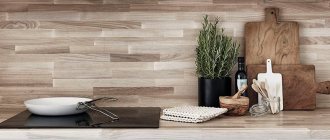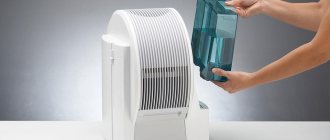Not so long ago, wall-hung toilets appeared in the bathrooms of our compatriots. In foreign homes, this plumbing innovation has already gained popularity and found its niche in the field of interior items that help save useful space and time for cleaning. Let's take a closer look at all the advantages and disadvantages of such a purchase, learn about the pitfalls of toilets with installations and how to choose the ideal model for your interior.
Types of toilet cabinets
Do you want to see what a toilet cabinet will look like? We have selected 200 of the best options to help you make your choice. After all, there are a large number of cabinets with different operational parameters and appearance.
Mounted
It is a universal solution for a miniature room, where it is most often located above the toilet. Such hanging furniture pieces on a mounting plate have a wide variety of sizes, depth, content and stylistic design.
The photo on the left shows a narrow wall cabinet above the cistern in the interior of a modern toilet.
Built-in
It has a fairly compact design, easily fits into the interior space and provides convenient access to the filling.
Floor
It is a free-standing model that can be equipped with legs, open or closed shelves.
Rack
It is a compact and ergonomic furniture element that can add versatility to even the smallest room. Forged racks have a particularly impressive appearance; they are not only a beautiful and elegant product, but are also suitable for storing towels, napkins and other hygiene products.
With doors
This option has different sizes, installation methods and designs. Wardrobes with hinged or sliding doors perfectly hide all contents and help create a neat interior.
Other options
Wicker baskets are suitable not only for towels: your cat will appreciate such a house. If in principle it doesn’t bother you that she will watch you.
The geometry of the room gives ideas for design. In this case, open shelves are not only useful for household purposes, they also visually straighten the wall behind the toilet (suitable for crooked walls!).
Combined option - open and closed shelves.
A mirror-cabinet allows you to use the wall space to the maximum functionally.
The problem is not solved? See: Best Ways to Hide Pipes in a Toilet
Placing a cabinet in the toilet
Where to make a closet in the toilet primarily depends on where the sewer pipe is located.
If a wide pipe is in a corner, it makes sense to choose a corner cabinet. He will help her and place everything she needs in the closet.
If the pipe is laid in the center of the wall, choose straight cabinet models.
If in your case there is no need to hide communications, and there is a water heating tank hanging above the toilet, take a closer look at floor cabinets with high support legs. Such models should be ideal in size for your toilet. If you cannot find a ready-made suitable model, you can always make a custom-made cabinet.
Cabinet behind the toilet
A convenient cabinet behind the toilet provides an excellent storage system for toilet paper, towels, air freshener and other small items.
The photo shows a pop art style toilet with a cabinet located behind the toilet.
Thanks to this placement, it is possible to free up space on the cabinet with a sink or shelves, which can be decorated with other beautiful decor.
Open niches
In this case, the niche performs a decorative function. The relief of the uneven surface and the contour of the recess are emphasized by spot lighting.
Diversity in a monochrome interior is achieved through the play of light. Volumetric decor fills the recess in the wall and casts interesting shadows.
An open niche laconically complements the minimalism in space.
Above the installation
Such a solution will be an excellent addition to the toilet, which does not overload or clutter the room. This arrangement not only allows you to hide communications, but also provides enough space to fill with other necessary things.
The photo shows a cabinet with a mirrored door above the installation in the interior of the toilet.
Corner cupboard
This cabinet is more suitable for medium-sized rooms; it can be installed on the right, left of the toilet, or on both sides at the same time. Such cabinets are a small, lightweight design with several shelves, with or without doors.
Hidden
It is distinguished by a very aesthetic appearance and, due to the facade part, which harmonizes and merges with the walls in the interior, creates the feeling of a complete plane, behind which there is actually a secret closet with a lot of things. Quite often, when finishing a toilet with tiles, the doors of the hidden box are also decorated with identical cladding.
Retractable
These multifunctional products allow you to save usable space and are therefore especially suitable for decorating a small toilet. Roll-out cabinets are often located near the toilet, which is very convenient.
Side
It perfectly complements the decor and, due to its thin and light forms, does not overload the space. This piece of furniture may be left or right-handed.
The photo on the right shows the interior of a small toilet, decorated with a narrow floor cabinet with drawers.
Freestanding models
The design mainly consists of open shelves. The advantage of this option is convenient access to things and the ability to hide some items behind the facades. The downside is that you need to constantly maintain order.
The cabinet takes into account the shape and dimensions of the toilet. This model can be found in showrooms or made to order. Or do it yourself: all you need is furniture panels, timber and fasteners.
Neoclassical-style furniture fills the entire wall space and forms a spacious storage area in the toilet.
The metal rack is compact; for such a design, the model of the toilet is unimportant. Decor and household items are stored on glass shelves.
The cabinet does not take up much space, but is quite spacious - ideal for a small bathroom. Frosted glass fronts hide the contents of the shelves.
Niches covered by a facade
Toilet interior in vintage style. The color of the doors is in harmony with the shade of the tiles.
Roller shutters cover a niche in the wall.
The façade material is painted white. The doors are fixed flush with the installation box.
The built-in wardrobe looks compact and provides access to communications. This, by the way, can be done very cheaply with your own hands.
White roller shutters do not stand out against the background of white walls. Despite the color division, the interior is perceived as one.
Interesting: how they hid the boilers in the closet behind the toilet (full description of the process and estimate)
The wood texture of the floor, cabinets and doors goes well with green ceramics.
The wenge door hides access to communications.
Ceramic finishing of the inspection hatch. In the closed position, the contour of the niche is almost invisible.
Built-in wardrobe, which is closed by furniture roller shutters.
Built-in cabinet above the toilet installation.
Access to the water heater through the inspection hatch.
Such products are equipped only with shelves and doors, and the rear and side walls represent the niche itself.
The photo shows the interior of a toilet with an open cabinet with lighting built into a niche.
Non-built-in built-in toilet
Often, ignorant users and some crazy experts call floor-mounted and wall-hung toilets, which are integrated with built-in tanks, “built-in”. Built-in tanks come in two types:
The tank is mounted on a durable steel frame, the so-called “installation”. First of all, the base is needed in order to attach a wall-hung toilet to it, secondly - for installing pipelines, and thirdly - as a frame for covering with plasterboard or other sheet material. For the most part, manufacturers offer installations of two types: some have a height of 115-120 cm, others 75-80 cm. The second allows you to install the lining flush with the washbasin built into the countertop. The frames are height adjustable by 4-8 cm.
A durable installation frame with a built-in cistern is designed for installing a wall-hung (not built-in!) toilet on it
Tank installed separately. It is insulated, equipped with the necessary fittings and fastening elements, and costs significantly less than an installation kit. Designed for use with tankless floor-mounted toilets.
The frameless cistern integrates with any type of cisternless toilet, including conventional floor-mounted and in-floor Turkish
Whatever ceramic buddy you decide to install in an apartment or private house, the installation of pipelines, connection and installation of a built-in toilet, cistern, installation, wall-hung or floor-standing bowl should be carried out by people knowledgeable in plumbing. If the topic is familiar, you can do it yourself. If you don’t have the skills or necessary knowledge, it’s better to invite specialists to avoid trouble.
Color design of the closet in the toilet
The choice of cabinet color depends on personal preferences and the style of the room. The classic design uses shades of white, beige, blue, and other pastel colors. Muted green, brown, sand, and ocher are suitable for eco-style rooms.
Bright colors, as well as contrasting black and white combinations and shiny metal are used in modern high-tech interiors.
The loft style requires its own solutions, the use of materials imitating brick, metal pipes left on display, translucent facades made of frosted glass or colored acrylic.
Even more opportunities are provided by making cabinets yourself. They can be decorated with mosaics, decoupage, stencil painting, etc.
Regardless of the size of the room and its style, a wardrobe, either built into a niche or any other, is undoubtedly a useful and beautiful piece of furniture that deserves great attention.
Decorating Tips
Some nuances become obvious only after encountering their manifestations. We will give some general recommendations that will allow you to avoid unpleasant moments during installation, finishing and operation of a wall-hung toilet.
- If you are finishing the partition between the toilet and the installation with tiles, then the water drain button should be placed in the center of the tile. Or at least along the seam. To do this, you need to start laying tiles from the drain button;
- Wall-hung porcelain toilets are preferable to sanitary ware, as they retain less deposits;
- The flush button also serves as a technological hatch for access to control valves.
- The distance between the holes for attaching a wall-hung toilet is 23 or 18 cm;
- If the flush button is mechanical, then the wall thickness between the wall and the cistern should not exceed 5 cm.
5 1 vote
Article rating
Making a sanitary cabinet with your own hands
It’s worth making a toilet cabinet yourself, as this allows you to take into account the individual needs of the apartment owner and significantly save on labor costs.
Accessories and fasteners
The plumbing closet for the toilet will get its finished look after hanging the doors. To do this, you need to prepare the fittings and decide on the number of doors. First, they take measurements of the doors and mark the frame for the hinges. Experts call piano hinges the best option. They are installed quickly and have high performance characteristics.
It is convenient to work with doors made of particle board. This material is quite moisture resistant and has a beautiful appearance. After hanging the doors, you should attach the handles. So it turns out that making a closet for a toilet with your own hands does not require much work.
Tools
An important stage of the preparatory period is the revision of the plumbing tools that will be needed to independently manufacture a cabinet for the toilet. The most necessary tools should be highlighted:
- water level and ruler;
- a set of screwdrivers, construction screws of different lengths;
- universal electric drill;
- electric jigsaw;
- marker and pencil;
- protective fabric for covering the floor.
A unique sanitary cabinet, beautifully made by yourself, will become the pride of the whole family. It would not be a sin to show a masterpiece of handicraft art to your neighbors.
Cabinet materials
The façade of a sanitary cabinet should be designed based solely on personal aesthetic taste and the performance characteristics of the raw materials. The frame of the cabinet can be made of wooden blocks, plastic, ferrous or non-ferrous metal.
Wooden blocks should be coated with moisture-proof decorative compounds. To construct doors for bathroom cabinets, wood, frosted glass, metal, waste from wood processing plants, enriched with natural veneer or decorative film are usually used.
Recommendations from experts
You can attach a mirror to the doors of the wall cabinet in the toilet. This will visually expand the space of a small room. To attach shelves to the side walls, it is advisable to use an aluminum corner 30x30 mm. The depth of the cabinet is determined based on the design features of the space behind the toilet.
The distance between the shelves should allow containers with household chemicals to be placed unhindered. Before installing a plumbing cabinet, you should make a visual inspection of the plumbing and water pipes.
Cabinet frame installation
The most common material for the frame of a built-in closet in a toilet is wooden blocks with a cross-section of 30x30 mm. They are connected to each other with steel corners using construction screws in accordance with the diagram. All wooden parts of the sanitary cabinet should first be treated with water-repellent compounds.
Using pre-applied markings, the wooden frame is attached to the side walls of the room.
Preparatory work
In order for the result to be as expected, you must first take the required dimensions of the room, make a diagram and a sketch of the cabinet in the toilet above the toilet on paper. It is also necessary to independently visually inspect water and sewer pipes, shut-off valves, and meters.
After compiling a list of the necessary materials, fittings and tools, you can go shopping at the nearest hardware store. Markings on the walls and ceiling are made with a pencil for attaching the cabinet frame to the toilet. You should decide on the number and size of household items that will fill the shelves.
Design ideas for cabinet doors
After viewing colorful photos on the Internet, it is not at all difficult to decide on the design style of the cabinet in the toilet behind the toilet. It is worth considering the most popular design solutions:
- swing doors. Closet doors in the toilet can have a wide variety of designs, colors and materials. It all depends on the personal aesthetic taste of the owner;
- sliding doors. This design does not require additional space when opening doors and will be a good solution for decorating a small room;
- wooden blinds. The door leaf is made of inclined strips that are attached to the door frame. This ensures air circulation in the cabinet.
Cabinet dimensions
The law does not prohibit the purchase of ready-made plumbing cabinets in a retail chain. However, a good owner will not miss the opportunity to save money, realize his experience, creativity and make his own closet in the toilet. The geometric dimensions of the cabinet are directly dependent on the shape and area of the plumbing room.
If the size of the room allows, you can install deep floor cabinets on both sides of the toilet. Elongated mirrors on both doors of the central wall cabinet in the toilet will add freshness and romanticism to the room.
Plumbing hatches
Used when space is limited and there is no need to store a large number of things in a niche.
Hatches made of plastic or metal are available in a variety of colors and sizes; the frame is fixed in the hole under the hatch, and the door is attached to it.
A tile hatch is made to individual sizes from a reliable base frame, taking into account the coincidence of the seams between the tiles on the hatch and the seams on the wall. A suitable option for organizing hidden, built-in wardrobes.
On the contrary, it can be made from tiles of a contrasting color or with patterns to create an accent in the space. This hatch requires skills in working with tiles.
Suspended model on a concrete base
A steel frame is expensive. In principle, you can do without it by building a concrete pedestal with your own hands, which will serve as a reliable foundation for the wall-hung toilet. This option is considered the most economical.
The diagram of the model on a concrete base includes: 1 – two rods for fixing the toilet bowl, mounted into the wall; 2 – concrete base; 3 – pipe for draining into the sewer
With this installation method, the drain container can either be mounted into the wall, with the drain button located outside, or placed above the bowl of the plumbing fixture.
Pre-installation procedure
Let's consider the option that is considered the least expensive. Let's prepare everything you need for work:
- concrete M200 - approximately 40 liters;
- boards for making formwork;
- threaded rods (length 50-80 cm, thickness 2 cm) - 2 pieces;
- washers, nuts, screws for woodworking;
- plastic pipe (diameter 11 cm, length 8 cm);
- drain coupling;
- Styrofoam;
- silicone sealant.
I think it’s worth repeating that the wall we have to work with must be permanent.
Step-by-step installation process
We fix rods in the main wall, onto the outlets of which the toilet bowl will then be placed. Let us remind you that we must have a stable and reliable structure that can withstand a weight of 400 kg.
The next step is to install the drain coupling. At this stage, it is necessary to determine the height of the toilet in order to cut the coupling to the appropriate length.
Now we need to install the formwork. In order to mark fastening points on the formwork, you should determine the distance between the holes intended for fastening.
To calculate the length of the rods, you need to add up the thickness of the recess, which is approximately 15 cm, and the distance from the wall to the toilet bowl. To fix the rods in the wall, concrete adhesive is used - a chemical anchor.
This is what the structure looks like ready for the concreting process: the place where the drain will be connected to the toilet bowl is covered with foam plastic
When the formwork is installed and the installation of the pins is completed, the bowl should be installed in the place intended for it. Make sure that the mounting holes match the outlets, and the outlet hole matches the coupling drain.
In twenty-eight days, the monolithic concrete support will be completely ready for installation. Pay attention to the groove in the front of the monolith - there was foam here
The next step is concreting. This must be done by installing foam plastic in the place where the drain hole will be. Remember that the concrete will finally harden only after 28 days.
After this, you can remove the formwork and make sure that in front of us there is a monolithic concrete block with pins coming out of it and an open, fixed coupling. A toilet is mounted to the front of the block, and a tank is placed on the base itself.
This is exactly what a wall-hung toilet will look like after installing the bowl, and its tank will be installed on a concrete base
The procedure for installing a bowl to a concrete base is no different from installing a floor-standing toilet. You need to install the bowl on the pins, tighten the nuts, connect and seal the drain. Lastly, a drain tank is placed on the concrete base.
As you can see, this method of installing a hanging model is much cheaper and easier than working with the installation. But, to be honest, the result is not much different from a floor-standing toilet.
Design of a small toilet with a cabinet
A small toilet room is equipped with narrow shelves that take up space above the toilet barrel, or a side wall or mini-models, with open or closed shelves that look very harmonious and neat.
Quite often they use products with mirrored facades, which make it possible to visually increase the dimensions of the room. Such cabinets do not contribute to cluttering the space, give the atmosphere a special lightness and allow you to radically change the design of the room.
Area from 2 sq. m
The main problem of toilet design is 2 sq. m. is the choice of plumbing and furniture. For a combined space, it is recommended to choose a shower stall and a mini-sink. If you need to place a bathroom, then it is better to install a narrow bowl or a corner option.
You should also abandon built-in plumbing, since it will take up most of the space for false wall equipment.
For lighting, 4-6 spotlights or a wall chandelier with mirror lighting are enough. Bright floor carpets, towels, vinyl stickers, and a pot with a green flowerpot are suitable as decorations.
Area from 4 sq. m
For a space of 4 sq. m. area should also be used sparingly. Choose small plumbing fixtures and furniture pieces. As decor, take those elements that effectively highlight the interior of the room.
Hanging furniture helps to create a complete room even in a combined bathroom, leaving a feeling of lightness. With such an area, it is already possible to use built-in shelves and niche cabinets, which increase the space and add storage space.
Attention! When planning a small toilet, it is important to take into account the standards. The distance between the walls and the toilet in a cramped room should be at least 150-250 mm.
Decor
Decorators have recently been massively abandoning the boring minimalist style in the bathroom. Gold elements are on trend, creating the effect of luxury, coziness and a unique atmosphere of comfort in the room. These include, for example, brass and copper components, gilding.
They harmonize well with many classic shapes and vintage, natural materials (a secluded sconce on the wall, a soap dish with a ceramic base, screw mixers). Here you need to not overdo it and maintain a uniform style in the room.
Lighting
High-quality sources of artificial light are important for the bathroom, because... There is often no window in the room. In some cases, the following lighting options are used:
LED strips, lamps;
central lamp attached to the ceiling of the toilet;
spot rotating and stationary lamps.
Devices can be located both on the ceiling and on the walls. In a room with a large area, an excellent solution would be to place a suspended ceiling system with a stepped configuration and several types of lighting. A lamp in the middle of the ceiling is considered an unsuccessful option for installing artificial light, because the light in the room should be diffused and slightly dimmed.
Attention! Properly placed lighting in a room visually expands the space.
Selection of furniture and accessories
The design of a toilet room is impossible without appropriate furniture. However, you need to take into account the size of the room: additional items are appropriate only if the space of the room allows them to be placed. This year the following are particularly relevant:
cabinets with built-in or overlay sinks;
non-standard shelving or hanging cabinet designs;
nightstand in a modern style.
Accessories should decorate the bathroom, but only in harmony with the general direction of the room, look stylish and beautiful. For example, for classics, products with a wood texture are suitable, while for a modern style, glass or plastic products and metal structures are more appropriate.
Standard accessories for the toilet are a mirror above the sink, figurines and flowers in pots on shelves and in niches, organizers for storing necessary little things, paintings, images or panels on the walls, a soft rug on the floor.
Functional bathroom decor items include a toilet paper holder, hooks or towel holders, a brush and door handles. They should be made in a single palette and be combined with the style of the room.
Built-in boiler
If you have enough storage systems in your apartment, but it’s hard to find a suitable corner for the boiler, then “settle” it in the toilet above the toilet.
To prevent the design from spoiling the aesthetics, build a plasterboard barrier that can be decorated with mosaics or other finishing materials.
Popular manufacturers of wall-hung toilets: Roca, Grohe, Cersanit, Villeroy, Laufen, Geberit
Wall-mounted toilets have already become a fashion trend. We are especially pleased with well-known global manufacturers of high-quality, certified plumbing fixtures. Among the most successful brands in demand by the public are:
•Roca. The original style is represented by a large number of modern ceramic models. Thanks to the innovative flush tank system, water consumption is significantly reduced and the noise during its release is reduced. The products are considered reliable, environmentally friendly, and durable. •Grohe. German works of art distinguished by high quality, innovative technology, stylish design and environmental friendliness. The presence of a dirt-repellent and antibacterial coating is considered popular among buyers. • Cersanit. A world-famous Polish brand, in demand in many countries. Wall-hung toilets from this company are ordered both for private use and for government or commercial structures. The products are highly durable. • Villeroy. The company constantly pleases customers with new lines and original models. Toilets have excellent performance characteristics and an attractive design. • Geberit. Consistent Swiss quality. Among the main goals of the manufacturing company are reducing water consumption, saving bathroom space, and the ability to stylishly decorate the room. • Laufen. Beautiful, modern plumbing. Any models of wall-hung toilets are developed in accordance with modern trends and requirements. Impact-resistant ceramics with a special protective coating are used in production.
Numerous collections of wall-hung toilets allow consumers to choose from a wide range of modern products. Such products can make the bathroom elegant, fashionable, and pretentious.
Decorative cabinet in the toilet room
This is primarily an interior decoration item due to the original design, mirror, glossy, transparent glass or other facades. At the same time, the cabinet retains its practical purpose, since it can also store some hygiene products: soap in beautiful packages or bottles, folded towels in drawers or baskets, napkins, paper, vases with plants, creams, room fragrances, etc. d. The catalogs of furniture manufacturers for sale and to order contain photos of various models of cabinets in the toilet.
Utility and decorative cabinets have different purposes, but their design and location may be similar.
Toilet and cabinet in green
The olive color of the walls will harmonize perfectly with yellow, pink, beige, peach, and gray. This combination of two desired shades (with a predominance of green) can create a special stylish atmosphere without the use of additional decor.
Toilet and cabinet in yellow
Sunny colors go well with all other bright and neutral shades. The best options are yellow with turquoise, yellow with white and yellow with olive. Plain sand motifs can be diluted with bright textiles and LED strips built into the mirror.
White small toilet with cabinet
The most optimal option for a small space, not only in terms of aesthetics, but also from the point of view of rationality. Snow-white tones can amazingly visually expand an area, making it more spacious. To prevent the room from looking too strict, you can use lamps of unusual shapes, a sink with designer patterns, or textiles with bright elements.
Brown toilet with cabinet
Coffee shades in toilet design always look stylish and expensive. The main thing is not to overdo it. Brown colors look great in combination with metal and wooden decorative elements, as well as with snow-white plumbing fixtures, which will visually appear even whiter. A harmonious combination of contrasts will create a special style of bathroom interior.
Blue small toilet with cabinet
Sky colors can appear either cool or warm. It all depends on the desired effect. There are many options for decorating a toilet using a blue tint. This could be blue and white mosaics on the walls, delicate turquoise wallpaper or marine patterns on the floor.
What is good and what is bad about a built-in toilet?
Despite the fact that “compacts”, a product of liberalism, have almost universally replaced floor-standing devices from domestic toilets, a toilet built into the floor has obvious advantages over a standard toilet seat:
- It is difficult to break, even when very drunk.
- In the same drunken state, if you fall in the toilet and hit your head, you can get a fatal injury on a regular toilet, but only a slight concussion on a Turkish one.
- Since the floor pusher does not have a seat, it cannot get dirty. This is a big plus if visitors are not accustomed to visiting the restroom in a civilized manner, do not consider it necessary to lift the toilet seat and strive to shit it. In the Turkish toilet, the reverse side of the visitor's Moon remains untouched, it does not come into contact with the snow-white porcelain.
- Cleaning a toilet with flush-mounted toilets is easier than with regular toilets. Waste that was not removed by careless users can simply be washed into the bowl with a stream of water from a hose, since it is located flush with the floor.
- The medical factor is also important. An experienced proctologist will confirm that sitting for a long time with a tablet or smartphone on a comfortable compact seat provokes a disruption of the blood supply to the hemorrhoidal veins with corresponding unpleasant consequences. The squatting position, typical for Turkish bowl users, is not conducive to spending a long time doing this activity. In addition, getting rid of toxins occurs more completely and, since it is necessary to maintain balance, various muscle groups of the visitor are trained. The energy consumption procedure will completely replace a session in an expensive fitness club.
Despite the undeniable advantages and considerable popularity in public toilets in many regions, Turkish toilets built into the floor are not used in private housing. People still prefer comfort to a healthy lifestyle and want to relax, read, chat, send SMS on a comfortable toilet seat.
Installation diagram of a floor-mounted built-in toilet. The sewer outlet-drain should be located 15-30 cm below floor level; such a device cannot be installed in a standard apartment
Utility cabinet in the toilet room
This type of cabinet can occupy a separate place in the room, if space allows, and serve to store many things: cleaning products and items, household chemicals, hygiene products, etc. At the same time, thanks to a thoughtful design, the cabinet can serve a decorative role.
In the style of minimalism
Functional simplicity and comfort are the ideal combination for a small toilet. Minimalism includes soft contrasts of light and dark shades (coffee and peach, white and gray, yellow and green), natural finishing materials (glass, wood, stone), as well as the absence of bulky decorations, which can be replaced by compact decorative lamps and panels on the ceiling.
Loft style
Industrial notes in design are becoming more and more popular every year. This is not surprising, because for a modern person, not only aesthetic, but also practical aspects are important. The ideal option for a small loft-style toilet is flat facades, wooden elements, a wall-mounted toilet and brick finishing on one of the walls. It will look simple, original and comfortable.
Provence style
The elegance of each individual detail and light color scheme can give a small toilet additional lightness and space. It is necessary to pay attention to textiles and decor. Preference should be given to linen towels and rugs, as well as paintings and mosaics that include floral elements and discreet ornaments.
Classic style
The toilet should be decorated in a classic style if the overall interior design is made in such a luxurious direction. Large chandeliers, ancient statues and metal mosaics will not be relevant for a small room. It is worth giving preference to antique sink shapes, antique mirrors and marble floors.
Cons of SI
Installations have not only advantages, but also disadvantages.
Overpriced
The price of the structure is 2 times higher than the cost of a traditional toilet, because you have to purchase plumbing separately. This is the main reason for not choosing such a device.
Inability to fit into the chosen interior
Not all design styles are compatible with hanging plumbing; it is not suitable for classic interiors.
Smaller sanitary ware
The installations can withstand loads of up to 400 kg, but the plumbing fixtures are smaller than standard. Using compact toilet or sink models is not convenient for all people.
Difficulty in repairing damage
Damage to the installation will require opening the bathroom wall. It is better to think through such nuances in advance and buy more finishing materials. In the event of a breakdown, it will be possible to do without repairing the entire room, but to restore one wall. It is unlikely that you will be able to fix the problem yourself.
How to choose a closet for the toilet
Plumbing stores offer many models of toilet cabinets. In order not to get confused, consider the main parameters of the product:
Cabinet size. Carefully measure the location of the future furniture placement. It is also important to measure the size of all the pipes you want to hide. Draw a schematic diagram of the future cabinet, do not forget to mark the recesses for communications.
Cabinet shape. For toilets with a niche, built-in models are suitable; if there is no niche, use the placement of pipes and meters as a starting point.
Appearance. The shape, color and texture of the facade should be combined with the overall style of the bathroom.
Availability of accessories. Depending on how the cabinet is attached, it should be supplied with dowels, brackets, fasteners and canopies.
Before purchasing, check that the packaging of the cabinet indicates that the furniture can be used in bathrooms and toilets. Such models are additionally treated with moisture-proof materials.
What is installation
Plumbing installation is a structure that hides communications, valves and pipes. The device is located behind a partition and is used to install a toilet without a bulk tank on a special frame. The concept of “installation” is defined by the following terms:
- modular fastener design;
- mounting elements;
- frames for placing sanitary products.
The device has the following characteristics:
- small size;
- water tank;
- neck for connection to drain communications.
Wall-hung plumbing fixtures are fixed with studs that pass through the structure, which prevents the toilet from being placed on the floor. The installation can be installed in a bathroom without a solid wall. The system allows you to use inaccessible room equipment or nodes with closed communications.
Brief historical background
The desire for functional use of space has led to the emergence of plumbing installations. Fastening systems appeared in the 60s. XX century
The founder of the design is considered to be the Swiss company Geberit, which created a flush tank with hidden installation for floor-standing toilets.
The company produces plumbing fixtures, metal-polymer pipes and fittings. Installations are supplied to Russia by Swiss, German and Finnish manufacturers.
Photos of toilet cabinets
Sources
- https://design-homes.ru/komnaty/vannaya-komnata/shkaf-v-tualet
- https://mebeldizajn.ru/shkaf-v-tualet/
- https://wcloset.ru/128-shkafchik-v-tualete-za-unitazom-30-variantov.html
- https://interer.guru/shkaf-v-tualet/
- https://giddesign.ru/shkaf-v-tualet/
- https://bestvannaya.ru/dizayn-tualeta/
- https://lafoy.ru/dizayn-malenkogo-tualeta-75-foto-17
- https://vannaitualet.ru/%D0%B4%D0%B8%D0%B7%D0%B0%D0%B9%D0%BD-%D0%BC%D0%B0%D0%BB%D0%B5% D0%BD%D1%8C%D0%BA%D0%BE%D0%BE-%D1%82%D1%83%D0%B0%D0%BB%D0%B5%D1%82%D0%B0/











